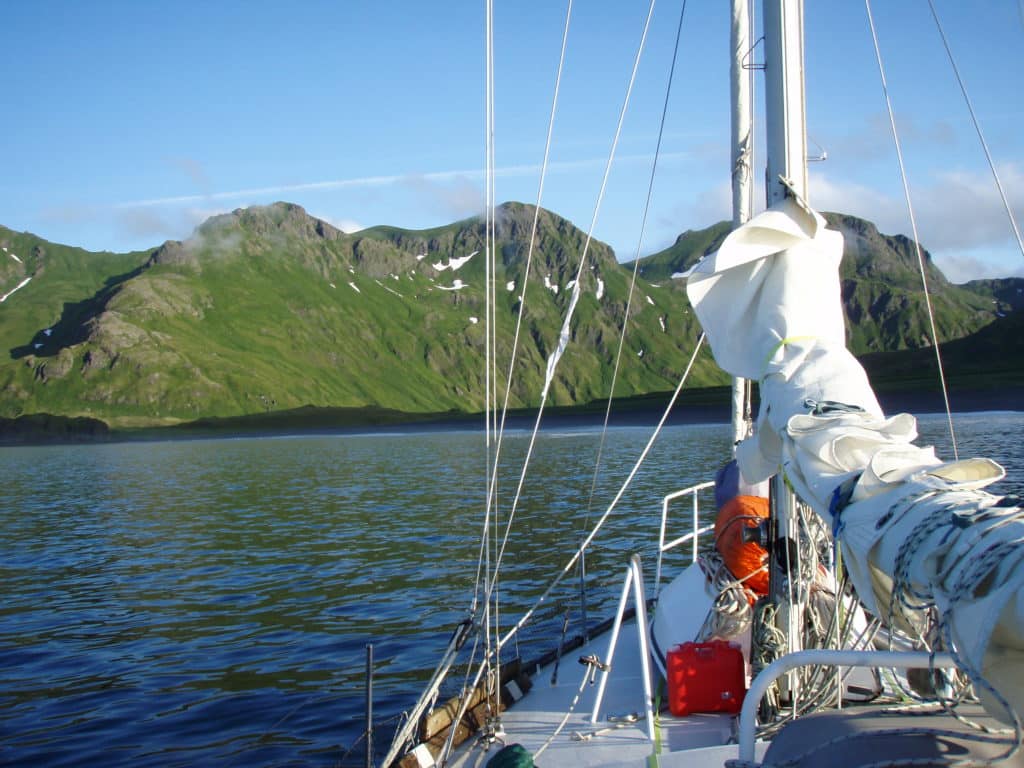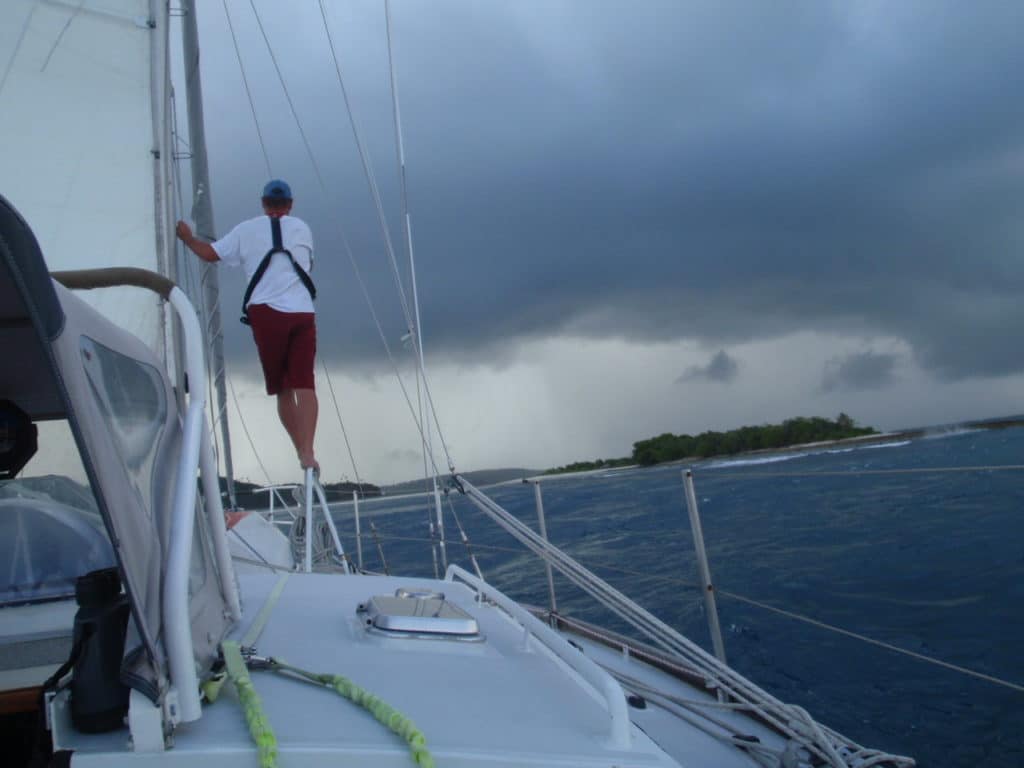
O Captain! My Captain! Our fearful trip is done, The ship has weather’d every rack, the prize we sought is won, The port is near, the bells I hear, the people all exulting …
The opening lines of Walt Whitman’s poem “O Captain! My Captain!” perfectly capture that magic moment in any sailor’s life — landfall! — the glorious culmination of years of saving, working, planning and now safely closing an oceanic passage. But beware! This is the most demanding and potentially dangerous phase of your voyage.
First and foremost, while most inexperienced sailors fear the unknown expanse of the open ocean, it is a relatively benign environment, affording time to think and the room and depth to maneuver. You are now approaching the crusty coast, and it is here the water shoals, the rocks rise and the passageways narrow.
Do not break with ship routine at the first sight of land. I once sighted the Marquesas Islands from 70 miles away. My crew and I sat at the helm in excited anticipation. Waning winds and contrary currents conspired to keep us from actual landfall for an entire day. We arrived far more exhausted than necessary.
Even the smoothest of voyages demand 24 hours of your mental attention and physical effort. The excitement of a new destination can mask a deep underlying fatigue, and that exhaustion undermines your otherwise good judgment. Outside a pass, you must stop, look and listen. Form a plan. Communicate that plan, and take these specific steps to ensure that, ultimately, your vessel will find safe haven.
Whereas you choose the weather and timing of your departure, you generally arrive when and where nature allows. This can be mitigated by speeding up or slowing down the vessel upon approach. The speeding up is seldom the best course of action, for it is better to slow down or even heave-to and arrive early the next morning (with up to 16 hours of daylight) than attempt a late-afternoon race against the cloak of darkness.
Before entering any pass after a long voyage, test all motoring functions. Is the day tank pumped up? Is the shaft break off? Are all fishing lines in? Has the transmission seized from disuse? Is the propeller compromised due to fouling?
Loosen up the windlass, for it may have sat in salt water for up to a month. Flake out a portion of chain, which may have piled up upon itself in the rough motion of a storm. Pull out fenders and mooring lines, as equipment may have shifted and buried them during the passage. Lay out the binoculars and the foghorn, and if the situation demands a late entry, the spotlight. Check the VHF and determine which channel Harbor Control operates on. Now is the time to hoist the quarantine and courtesy flags, not once in the thick of action.
If time and tide permit, sit outside any entry and watch the local vessels. Note where and how they enter, but do not necessarily assume that this is the safest entry for you. A shoal-draft fishing punt might be slipping over skinny water that a deep-keeler could not, whereas a container ship would certainly be safe to follow. Use their passage to confirm which marking system is in use because red-right-returning is not universal (see Red Right Returning.) Never rely on informal markers; it is a lottery as to whether they mark a danger or the route around one. Extrapolating another ship’s course can help locate range markers and low-lying navigational aids.
We can become so focused ahead that we forget to scan the horizon behind. Being chased up a narrow channel by a 50,000-ton freighter is best avoided. On that note, remember, given container ships’ size, speed and limited maneuverability, there is no such thing as right of way. Always consider yourself the burdened vessel.
Next, take time to note the weather and winds. Do not assume that your offshore conditions will continue once in the influence of large landmasses. Their thermal properties can override prevailing conditions, causing onshore and offshore breezes as the land heats and cools throughout the day. In steep terrains, katabatic winds can thunder down upon you from any direction. Develop natural literacy. Interpret the landform; look ahead for tell-tale signs on the water. If line squalls are coming through, sit still to watch their frequency, ferocity and shifts. Halfway through a coral pass and all the way out of visibility is not for the fainthearted.

Use your chart plotter, GPS, radar, depth sounder and any other modern navigational aid possible, but do not neglect to simply stand up and look around because, especially in reef-strewn waters, the charting can be inaccurate, extreme weather events can take out aids and channels might shift. Confirm your modern data with correlating depth soundings, water colors and flow patterns.
Always have the sails ready to go if not already in use. It is an immutable law of nature that if your engine is to fail or your propeller is to pick up a semisubmerged fishing net, this will happen smack in the middle of a tortuous channel. Because it is always easier to shake out a reef than to put one in, I take a tuck before entering a strange harbor, even in light winds. The emphasis here is on safety, not speed.
Unless other marine traffic prevents it, always enter any pass favoring the windward side. In the event of trouble, you can quickly jibe out with maximum room, instead of relying on a successful tack with only half a pass available.
Check the local tide tables, and ensure that you have the right time zone and any correction for daylight saving time. Slack water does not always coincide with high or low tide. Check the chart and/or tide tables for anomalies. Remember that in the case of coral atolls, even on the flood tide the current is usually flowing out the pass. This is due to a higher sea level within the atoll caused by waves continuously breaking over the enclosing reef. If possible, time your entry for slack low water. In the event of grounding, you will have the full effect of a rising tide to refloat or kedge off. Shoaling is also easier to spot at low water. Silly as it sounds, watch the birds on the water: Are they swimming or wading?
The position and height of the sun is of primary concern, especially in coral environments. Try to place the sun behind you, moderately high but not dead overhead. If the pass is twisting, anticipate sun strike, and plot out a route in your mind before you lose color perception. Wear clean, polarized sunglasses, even on an overcast day, because they pierce the glare on the water’s surface and exaggerate color differential. Find an elevated yet safe position to keep watch ahead. Even a little extra height will dramatically improve visibility through the water. Take every opportunity to practice interpreting local colors as they relate to depth.
Upon your entry into the anchorage area, you probably will be spotted by friends on other boats. They will be excited and want to chatter on as to how your voyage went. Remember, your voyage is not over just yet. Politely shout to them, “We’ll talk soon, as soon as the boat is safely anchored.” They will respect that. Take extra caution in anchoring. Strange ports with unknown holding ground can be crowded with vessels of differing scope. You will sleep the sleep of the dead the first night in, and probably not be as tuned in to any wind shifts or water changes as you normally would.
However well intended advice from strangers might be, never do exactly as told by people on the dock unless you, as captain and solely responsible for the safety of your vessel, have determined that it is the best course of action. Only you know your draft, maneuvering characteristics, and the agility of your line handlers. When coming dockside, use your own lines. If someone dockside has offered assistance, do not be afraid to instruct them as to exactly how you want the lines run and made fast.
Do not break quarantine by letting someone jump on board or by leaving the vessel, even if told that local procedures are very casual. This wonderful voyage is officially completed only once the Q-flag comes down.
Congratulations — you’ve done it! You will experience a profound sense of relief, joy and pride. Now is the time to pop that cork and toast yourself and your crew on a job well done.
Two-time circumnavigator and author Alvah Simon is a contributing editor to Cruising World.








